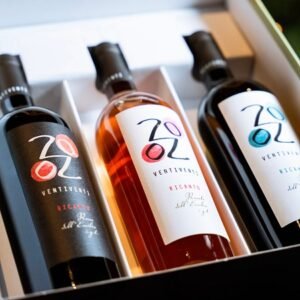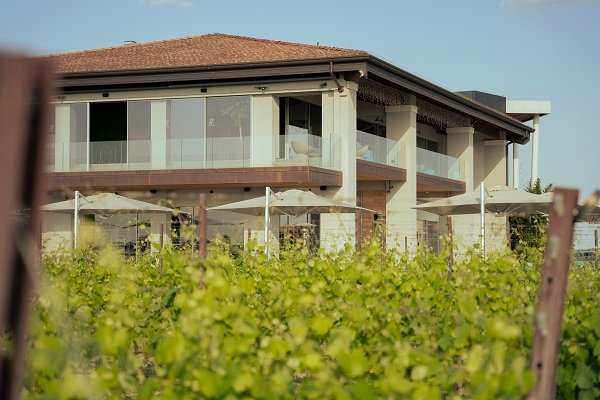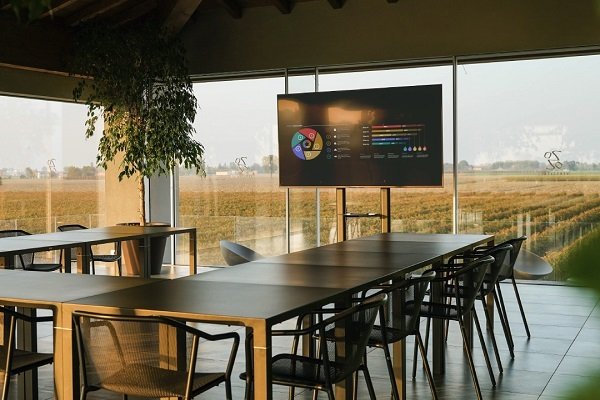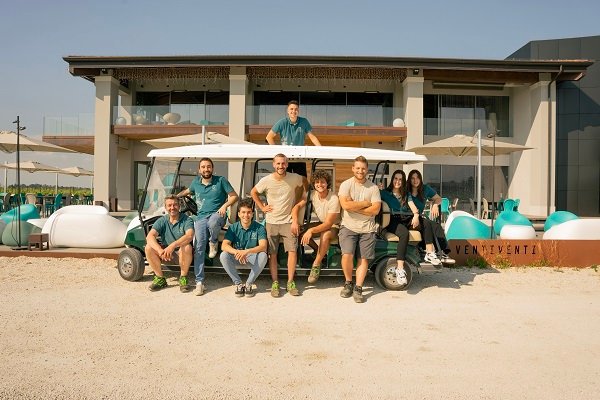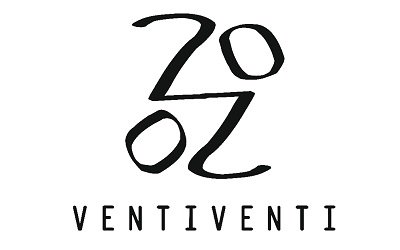Given the three owners and staff members, the average age in the Ventiventi winery is 27. The land, Emilia-Romagna, has known the vineyard for millennia. And if it is true, as it happens, that new inspirations can be born from juxtapositions, in Medolla, in the heart of the region in the province of Modena, the young Ventiventi winery will have much to tell.
The story is young and fast-moving: in 2014 Vittorio Razzaboni, a local entrepreneur, set up an agricultural company, “Il Borghetto,” with the memory to a street in Cividale where both he and his father grew up, and the idea to an ambitious project for the future.
And then he has three sons, who are perhaps among those young people (a miracle that happens among those who deal with the land) who do not find it indispensable to go abroad to find their own way. In 2015 the farm became structured with the acquisition of 18 hectares of land and the following year with the planting of the vineyard on the entire property.
The vineyard operation was immediately born organically set up so as to be as energy self-sufficient as possible in both the winery and the vineyard. In 2018, the first – small – harvest starts, with a precise plan: the production of Metodo Classico sparkling wines.
In 2019 another 27 hectares are acquired, of which 12 are destined for vineyards. Then other mergers follow to arrive at a total, to date, of 70 hectares of property: 30 planted with vines, the rest committed to arable land.
The winery
Dad Vittorio acquires, stabilizes, and is there when needed, but he quickly steps aside and leaves the field clear for his sons, who in 2020, despite the Coronavirus pandemic, officially start: so the company, in honor of its year zero, will be called VentiVenti. 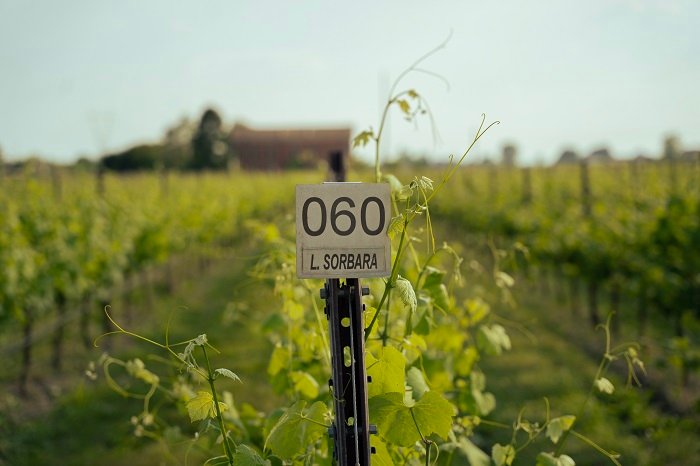 It will be run by the Razzaboni’s eldest son, Riccardo – vintage 1994 – who is in charge of sales and foreign markets; Andrea – vintage 1997 – oenologist, who for now follows the entire supply chain; and the youngest, Tommaso – vintage 2002 – who is studying oenology and seems to have an excellent palate.
It will be run by the Razzaboni’s eldest son, Riccardo – vintage 1994 – who is in charge of sales and foreign markets; Andrea – vintage 1997 – oenologist, who for now follows the entire supply chain; and the youngest, Tommaso – vintage 2002 – who is studying oenology and seems to have an excellent palate.
“We are structuring ourselves so that each of us knows how to do everything in the winery ,” Andrea says. We need to be interchangeable, the goal is to create a very dynamic team, to grow together and gain comprehensive knowledge. We want to make sure that if one day any of us, growing up (wise guy) decided to take another path, his absence would not go to the detriment of the company.”
Finally in 2021 the real commercialization begins, the winery is officially presented and the hospitality business is also launched. “For now, and in order not to leave any sector uncovered,” continues Andrea – We devote two days to hospitality, with tastings and catering. The rest of the time we devote to wine production.”
Organic soils and management
 The winery is located in the northern belt in the Lambrusco scenario, where the soil is distinguished, compared to the neighboring predominantly sandy belts, by the presence of a good 45 percent clay “which,” Andrea stresses, ” allows us to have wines with character and good structure, always balanced by the marked acidity that characterizes the products of our territory,” and they are in the plains, in a climatic situation that tends to develop a certain humidity.
The winery is located in the northern belt in the Lambrusco scenario, where the soil is distinguished, compared to the neighboring predominantly sandy belts, by the presence of a good 45 percent clay “which,” Andrea stresses, ” allows us to have wines with character and good structure, always balanced by the marked acidity that characterizes the products of our territory,” and they are in the plains, in a climatic situation that tends to develop a certain humidity.
“But early harvests, which are necessary for winemaking to produce Metodo Classico, shelter us from the vagaries of the climate, even with the difficulty of totally organic management. We pander to soil and climate, but we also rely on technology, such as the use of precision drip irrigation that reduces water consumption, and that of systems to limit the use of copper and sulfur. We do not rely on chemistry for the success of our wines, but on a managed balance of nature.”
Grape varieties
The grape varieties planted refer to the tradition of the area: the Sorbara, Salamino di Santa Croce, Pignoletto and Ancellotta, as well as a small support of internationals such as Pinot Bianco, Chardonnay and a small vineyard of Traminer. “We believe a lot in our grape varieties, we aim to enhance them because we are certain that they can give much more, or even different, than just tradition.”
THE WINES.
Classic Method
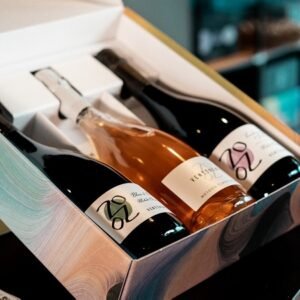 The two headliners of the production are the Blanc de Blancs, Spumante Brut Pignoletto Doc, 100% Pignoletto: it is a name that suggests tasting the wine without the preconceptions associated with the grape variety. 24 months on the lees and 18 months after disgorgement before release. It is a wine that seeks structure while maintaining notes of freshness and pleasantness typical of the grape variety.
The two headliners of the production are the Blanc de Blancs, Spumante Brut Pignoletto Doc, 100% Pignoletto: it is a name that suggests tasting the wine without the preconceptions associated with the grape variety. 24 months on the lees and 18 months after disgorgement before release. It is a wine that seeks structure while maintaining notes of freshness and pleasantness typical of the grape variety.
The other is Lambrusco Salamino di Santa Croce Spumante Brut Doc: 20% vinified in red in contact with the skins, with a ruby red color that the initial roundness is accompanied by a taut, vertical finish. In the VentiVenti line, always Classical Method, the sparkling process engages both local and great international grape varieties, is always very low in sugar to give more identity to the product and search for freshness for a dynamic and versatile drink.
- VentiVenti Rosé, brut sparkling wine, 100% Sorbara, the centerpiece of production About 25,000 bottles.
- VentiVenti Brut, 85% Chardonnay and 15% Sorbara
- VentiVenti Pas dosé, 65% Pinot Blanc, 20% Chardonnay 15% Sorbara
Emilia Igt
In the Igt of Emilia, the Ricanto Line, whose name comes from the fusion of the initials of the three brothers’ names, comes in Bianco (Traminer aromatico), Rosato (Sorbara), and Rosso (Ancellotta) versions. This is a project with limited quantities, just a few bottles, for almost exclusively local use.
Niche wines, commitment to social work
La.Vie Lambrusco Rosso di Modena Doc, Charmat Method, 100% Sorbara. A very traditional sparkling wine, aiming for the beautiful side of an immediate but not trivial drink, with a dry finish.
Then there is Happy Selvaggio Ancestrale, Lambrusco dell’Emilia Igt, a project created together with AstronaveLab – an association that unites young people with disabilities – who are present in the winery in all the production phases of this wine: during the harvest, bottling and in the graphic design of the 12 labels with which it is presented.
“They go home with a sense of belonging that also gratifies them materially, because part of the sale of the bottles they help us produce goes to the association. It’s good for them, but also for us and our team, each experience is a stimulus, we are all very motivated”, Andrea proudly states.
“Ours is a team that is predominantly composed of young people who live 2 kilometers from the company and feel a part of it and responsible for it.” The average age on the farm is just low: the vineyard manager, perhaps the oldest, is 31, the reception manager is 24. Other young people who remain anchored to their land.





